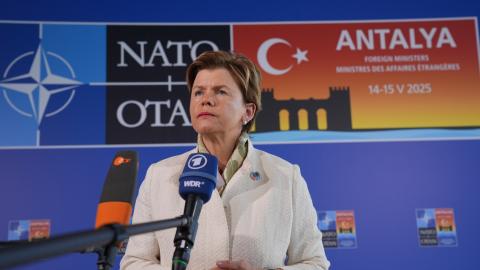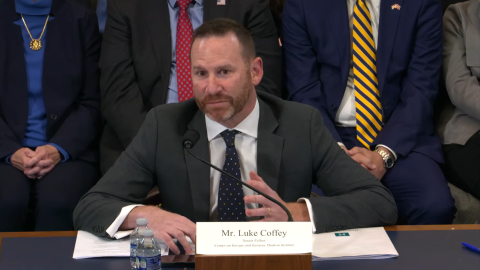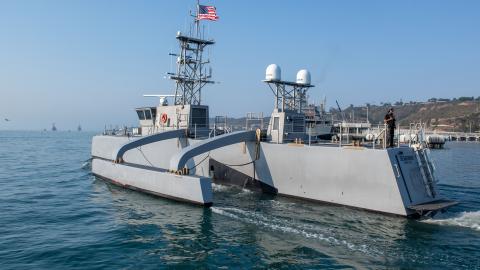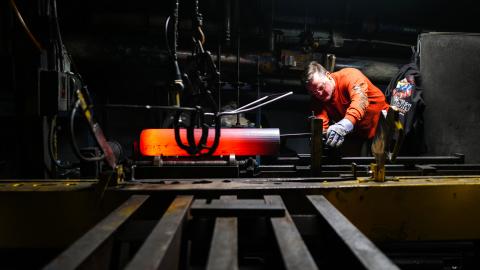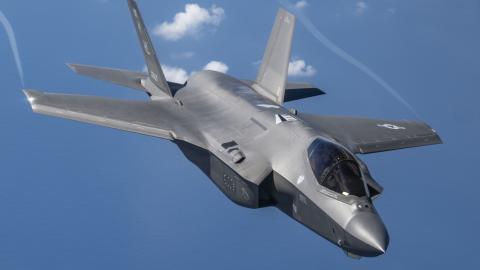In his first high-profile speech since taking office Air Force Secretary Troy Meink argued that the U.S. Air Force is dominant today, but also needs to mount the most aggressive modernization and readiness campaign in its nearly 80-year history. That paradox highlights a failure at the heart of the service’s current design. The only way it can stay ahead is by growing and improving at an ever-increasing — and unsustainable — pace.
It’s no mystery why this happened. The Air Force’s fighter-centric design depends on bases close to the enemy. Recent attacks in Russia, the Middle East, and Ukraine show that bases are easy targets for drones, missiles, and drone-missile hybrids being built by everyone from informal terrorist groups to major powers.
But flying from farther away demands more refueling tankers and fighters, both of which are getting more expensive to buy and maintain. And distributing operations, as in the Air Force’s Agile Combat Employment concept, merely changes a near-impossible defensive challenge into a near-impossible logistics one.
The service cannot solve its problems by expanding today’s force or chasing game-changing technologies. It needs to return to the core of military advantage — operational innovation. The Air Force should adopt a new design that exploits the principles of combined‑arms warfare, as the U.S. Army did when faced with Soviet numerical superiority.
The end of ‘one-size-fits-all’
The Air Force’s current design reflects post-Cold War U.S. military dominance. Because it was broadly superior to opponents, the same Air Force could be used in any situation and succeed. China’s dramatic military modernization and the proliferation of precision strike technologies demand a new approach. In this post-dominance era, a new force design would use specialized capabilities and postures to counter challenging threats like that posed by China.
The first element, the edge force, would employ small, mobile teams on the ground with one-way attack drones and surface-to-air missiles operating close to or underneath the PLA’s defensive umbrella. These units would rely on rapid movement, stealth, and surprise to destroy key surface targets and disrupt enemy kill chains through localized but lethal offensive air denial.
The second element, the pulse force, is a decisive lever. Operating from sanctuary with resilient tanking, bomber formations would deliver episodic, high‑volume salvos that first strip naval escorts and air defenses and then sever command and sustainment nodes ashore. The pulse force would execute attacks against well-defended targets by using friendly sensor networks to exploit windows when the edge force disrupts enemy sensors or aircraft.
The core force of fighters, collaborative combat aircraft, tankers, and support platforms would enter in strength only after the edge and pulse forces reduce the enemy’s ability to attack at scale. The core force would then use survivable forward bases to sustain counter-air and strike operations.
Most of today’s Air Force is the core force, which would remain the go-to element of airpower for most scenarios. But the new Air Force chief will need to shrink the core force and shift resources to pulse and edge forces to address the full range of situations the service could face.
Keeping credibility
The Hudson Institute’s wargaming and campaign modeling suggest the three-part force design works in a stressing Taiwan invasion scenario. Using today’s traditional fighter-centric approach, about 60 percent of the Chinese assault force survives to execute landings by the campaign’s end.
Under a combined arms concept, edge force missiles or one-way attack drones and pulse force bombers annihilate the invasion fleet and its escorts, respectively. Only a single invasion vessel survives from the first wave of nearly 300 ships.
But the new force design’s more important benefit is reducing losses. Under the traditional, fighter-centric model, enemy strikes and air defenses will likely destroy the majority of U.S. combat aircraft deployed to the region. Faced with this potential, an American president may choose not to intervene on Taiwan’s behalf.
But with the new force design, the edge force contests airspace over the first island chain to reduce enemy counter-air patrols and bombing runs while the pulse force attacks amphibious forces from standoff range. Few U.S. aircraft are lost.
Stopping the first wave doesn’t end the war, but by protecting its core and reducing losses overall, the Air Force can fight deeper into the conflict. As a result, the new force design enhances U.S. deterrence by offering a higher probability of success and lower likelihood of catastrophic causalities.
Traditionalists will argue that the Air Force should not be in the business of ground-based missiles and runway-independent drones. They will also question the wisdom of shrinking the fighter fleet and other elements of expeditionary airpower to build an edge force and expand the pulse force. After all, the existing Air Force design has proved effective in every conflict since the Cold War.
But we just watched the larger traditional, Russian military struggle against a Ukrainian force that essentially didn’t exist three years ago. To avoid being disrupted in its next conflict, the U.S. Air Force should stop waiting for a windfall and start innovating.

